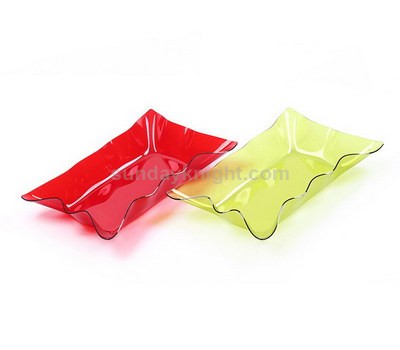Culinary art has long been a canvas for creativity, blending taste and aesthetics in a way that delights both the palate and the eyes. In recent years, an unconventional yet increasingly popular medium has emerged in the world of fine dining: the acrylic plate. These sleek, modern plates are transforming how chefs present their culinary masterpieces, offering unique advantages and inspiring new trends in food presentation. This article explores the distinctive uses and benefits of acrylic plates in culinary art.



Aesthetic Appeal
Acrylic plates are celebrated for their contemporary and minimalist design. They provide a clean, transparent backdrop that allows the food to be the star of the show. Unlike traditional porcelain or ceramic plates, which can sometimes overshadow the dish with their own patterns and colors, acrylic plates offer a neutral canvas that enhances the visual appeal of the food. The transparency of acrylic plates creates an almost floating effect for the dishes, adding an element of surprise and intrigue for diners.
Versatility in Presentation
One of the most significant advantages of acrylic plates is their versatility. They come in various shapes, sizes, and thicknesses, allowing chefs to experiment with different presentation styles. From delicate appetizers to elaborate main courses, acrylic plates can accommodate a wide range of culinary creations. Their lightweight nature makes them easy to handle, enabling chefs to focus on the intricate details of plating without worrying about the weight and fragility of traditional plates.
Moreover, acrylic plates can be customized with engravings or designs, adding a personalized touch to the dining experience. Restaurants can incorporate their logos, patterns, or even seasonal themes onto the plates, making each dining experience unique and memorable for their guests.
Practical Benefits
Beyond their aesthetic and versatile qualities, acrylic plates offer practical benefits that make them an attractive choice for both professional kitchens and home cooks. They are highly durable and resistant to breaking or chipping, which is a common issue with ceramic and glass plates. This durability not only ensures a longer lifespan for the plates but also reduces the risk of accidents in the kitchen and dining area.
Acrylic plates are also easy to clean and maintain. Unlike porous materials that can absorb stains and odors, acrylic is non-porous and can be quickly wiped clean or washed with mild soap and water. This ease of maintenance is particularly beneficial in busy restaurant environments where quick turnover and cleanliness are paramount.
Enhancing Dining Experiences
The use of acrylic plates can significantly enhance the overall dining experience. Their modern and elegant appearance sets a sophisticated tone, creating a sense of occasion and elevating the perceived value of the meal. Diners are more likely to appreciate the chef’s artistic effort and attention to detail when the presentation is elevated by the sleek and stylish look of acrylic plates.
Furthermore, acrylic plates can be used to create interactive and immersive dining experiences. For instance, they can be integrated with LED lighting or placed over screens that display dynamic visuals, creating a multisensory experience that captivates diners. This innovative use of technology in conjunction with acrylic plates pushes the boundaries of traditional dining, offering a novel and unforgettable experience.
Environmental Considerations
While acrylic plates offer numerous benefits, it is important to consider their environmental impact. Acrylic, a type of plastic, is not biodegradable and can contribute to plastic waste if not disposed of properly. However, many manufacturers are now producing acrylic plates that are recyclable, and some are even made from recycled materials. Chefs and restaurateurs can make environmentally conscious choices by selecting acrylic plates from sustainable sources and ensuring proper recycling practices.
Conclusion
Acrylic plates represent a fusion of modern design and practical functionality, offering chefs a unique medium to showcase their culinary artistry. Their aesthetic appeal, versatility, durability, and potential for enhancing the dining experience make them a valuable addition to any kitchen. As the culinary world continues to evolve, acrylic plates are likely to play an increasingly prominent role in redefining food presentation, inspiring chefs to push the boundaries of creativity and innovation. While mindful of their environmental impact, the thoughtful use of acrylic plates can elevate the art of dining to new and exciting heights.
